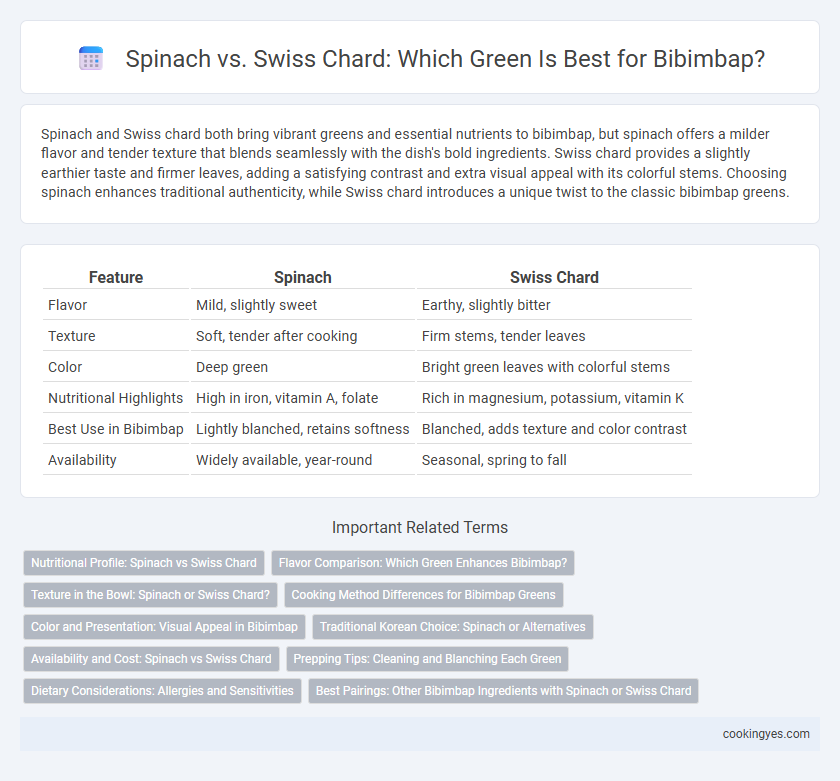Spinach and Swiss chard both bring vibrant greens and essential nutrients to bibimbap, but spinach offers a milder flavor and tender texture that blends seamlessly with the dish's bold ingredients. Swiss chard provides a slightly earthier taste and firmer leaves, adding a satisfying contrast and extra visual appeal with its colorful stems. Choosing spinach enhances traditional authenticity, while Swiss chard introduces a unique twist to the classic bibimbap greens.
Table of Comparison
| Feature | Spinach | Swiss Chard |
|---|---|---|
| Flavor | Mild, slightly sweet | Earthy, slightly bitter |
| Texture | Soft, tender after cooking | Firm stems, tender leaves |
| Color | Deep green | Bright green leaves with colorful stems |
| Nutritional Highlights | High in iron, vitamin A, folate | Rich in magnesium, potassium, vitamin K |
| Best Use in Bibimbap | Lightly blanched, retains softness | Blanched, adds texture and color contrast |
| Availability | Widely available, year-round | Seasonal, spring to fall |
Nutritional Profile: Spinach vs Swiss Chard
Spinach offers a higher concentration of iron and folate, essential for boosting energy and supporting cell growth in Bibimbap greens. Swiss chard provides more vitamin K and magnesium, which aid in bone health and muscle function. Both leafy greens contribute antioxidants and fiber, making them valuable nutritional components in a balanced Bibimbap dish.
Flavor Comparison: Which Green Enhances Bibimbap?
Spinach offers a mild, slightly sweet flavor that complements the bold, savory elements of bibimbap without overpowering them, enhancing the dish's balance. Swiss chard provides a more robust, earthy taste with a subtle bitterness that adds complexity to the bibimbap's flavor profile. Choosing between spinach and Swiss chard depends on whether a lighter or more intense green flavor is desired to elevate bibimbap.
Texture in the Bowl: Spinach or Swiss Chard?
Spinach offers a tender, delicate texture that softens quickly when mixed into bibimbap, creating a smooth and cohesive bite. Swiss chard provides a firmer, slightly crunchy texture that holds up well against the heat of the bowl, adding a robust mouthfeel. The choice between spinach and Swiss chard impacts the overall texture balance, with spinach blending seamlessly and Swiss chard contributing a satisfying chew.
Cooking Method Differences for Bibimbap Greens
Spinach requires a quick blanching method to preserve its tender texture and vibrant green color, ideal for the fresh, slightly sweet flavor desired in bibimbap greens. Swiss chard, with its thicker stems and heartier leaves, benefits from a longer sauteing or steaming process to soften its fibrous texture and mellow its earthier taste. These distinct cooking methods influence the overall texture and flavor profile of bibimbap, ensuring the greens complement the dish's balance of savory and umami elements.
Color and Presentation: Visual Appeal in Bibimbap
Spinach brings a vibrant, deep green hue that enhances the traditional visual harmony of bibimbap, creating a rich contrast against the bright red gochujang and yellow egg yolk. Swiss chard offers a more varied color palette with its emerald leaves and colorful stems in shades of red, yellow, or white, adding a unique and eye-catching element to the dish. The choice between spinach and Swiss chard for bibimbap greens directly impacts the dish's presentation, with spinach providing classic authenticity and Swiss chard introducing a bold visual twist.
Traditional Korean Choice: Spinach or Alternatives
Spinach remains the traditional choice for bibimbap greens due to its tender texture and mild flavor, which complement the dish's bold, spicy sauces. Swiss chard presents a colorful alternative with a slightly earthier taste and robust leaves that hold up well during cooking. While spinach maintains cultural authenticity, Swiss chard offers a nutritious, visually appealing option for modern variations of bibimbap.
Availability and Cost: Spinach vs Swiss Chard
Spinach is widely available year-round in most grocery stores and tends to be more affordable than Swiss chard, which might be seasonal and less commonly stocked. The consistent price and easy access to fresh spinach make it a budget-friendly option for bibimbap greens. Swiss chard, while nutritious and flavorful, often carries a higher price and limited availability, impacting its practicality for regular use.
Prepping Tips: Cleaning and Blanching Each Green
For prepping spinach in bibimbap, thoroughly rinse the leaves under cold water to remove dirt and grit, then blanch briefly in boiling water for 30-60 seconds to soften while retaining vibrant color and nutrients. Swiss chard requires a similar process but benefits from a slightly longer blanching time of 1-2 minutes due to its thicker stems, ensuring even tenderness. Both greens should be immediately shocked in ice water after blanching to halt cooking and preserve texture for perfect bibimbap presentation.
Dietary Considerations: Allergies and Sensitivities
Spinach contains oxalates that may trigger sensitivities in individuals prone to kidney stones, while Swiss chard offers a similar nutrient profile with slightly lower oxalate levels. Both greens are rich in vitamins A, C, and K, but spinach's higher folate content benefits certain dietary needs. When preparing bibimbap, those with allergies to nightshade vegetables should be cautious with Swiss chard, as it belongs to the same family, unlike spinach.
Best Pairings: Other Bibimbap Ingredients with Spinach or Swiss Chard
Spinach pairs exceptionally well with classic bibimbap ingredients such as seasoned bean sprouts, mushrooms, and gochujang, enhancing the dish's fresh and earthy flavors. Swiss chard complements grilled beef, kimchi, and fried egg, providing a slightly bitter contrast that balances the richness of these toppings. Both greens absorb sesame oil and garlic seasoning effectively, making them versatile options for varied bibimbap combinations.
Spinach vs Swiss Chard for Bibimbap Greens Infographic

 cookingyes.com
cookingyes.com